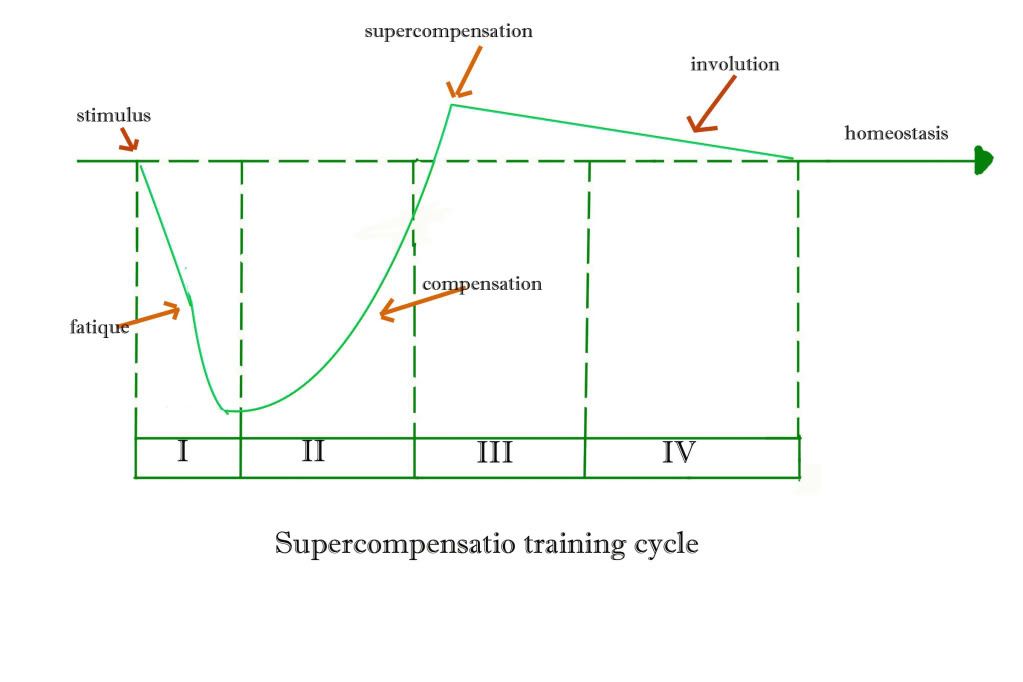Supercompensation is mostly relied to relation
between work and recovery as a biologic basis for physical and psychological
stimulus before the main competition. All individuas have specific quantity of
biological functioning that dominates during normal daily activities. When unit
trains, series of stimuli distracts normal biological condition built by
burning of additional nutrition things. Final
result of that burning is fatique and high concentration of lactic acid. In the
end of training quantity of fatique temporarily decreases body functionality.
Sudden decrease in homeostasis curve
describes fast fatique action which presents in the same time decrease in
functional capacity. After training and between two trainings body fills biochemical
energy sources during the phase of compensation. For sportsmen normal
biological behaviour always has to exist the balance between consumption and
intake. During the compensation what is consumpted during training, has to be
recovered. If you don’t do that, emptying of supplies will result with
performance decrease.
Curve returnal to the normal biological
condition is easy and progressive, which tells us that regeneration of body
energy and its recharge an easy process that requires few hours. If the time
between two high intensity trainings is longer, body will completely switch
consumpted sources(glycogen especially). Athlete achieves that by creating the
proper reserves, allowing body to return in the condition of supercompensation.
Each time when it comes to supercompensation, an athlete gets new increased
homeostasis quantity with positive effects on training and performance.
Supercompensation should be viewed as the basis of functional performance
improvement, at which it comes by body adjustment on training stimulus and
charge of glycogen in muscles. If resulting phase or time between two
stimuli is too long, supercompensation will weaken, which will lead into the
phase of low progress in performance.
Supercompensation
cycle look like this(see the picture below the bold text):
After
use of exercises on training, body will feel fatique(phase I), during rest
phase(phase II) biochemical supplies are not only charged, but also overcome
normal quantities. Body completely compensates after which the phase of
supercompensation goes(phase III), when higher adjustment appears, doubled by
functional increase in sports result. If sportsmen doesn’t use a new stimulus
in optimal time(during supercompensation phase), than it comes to
involution(phase IV) that represents the lost of positive advantages that were
given during supercompensatio phase.

After optimal stimuli on training, recovery
phase, including supercompensation phase, lasts about 24 hours(Herberger,
1977). Variations in supercompensation depend of training type and intensity.
For example, after aerobic endurance training, supercompensation can be
appeared after 6-8 hours. On the other side, at intensive activity that puts
high demands on nervous system, it may be needed more than 24 hours, and
sometimes 36-48 hours, to appear supercompensation.
However, top athletes follow programes that do
not enable 24 hours recovery between two trainings, they will do the second
training before it comes to supercompensation. Quantity of improvement is
bigger when sportsmen agree on more often trainings if trainings are not that
often to stop the phase of supercompensation. Long term rests between trainings will result in lower total progress
than short term rests. In this other case, sportsmen has to change energy
compositions that he uses as it is proposed in microcycles training.
The power of various stimuli has direct
influence to body reaction on training. The phase in which is overstated the
maximum intensity stimuli will lead to exhaustion and decreased performance.
That is typical stance of some coaches that have an intention to keep the image
of toughness and hard work and that believe that sportsmen must reach
exhaustion on every single training. Under these circumstances, athletes never
have enough time for compensation, cause deep of the fatique curve goes deeper
and deeper, which requires more time for regeneration, and not one more hard
training. Regeneration will enable compensation and in the end
supercompensation.
To
constantly improve the performance, coach regularly has to challenge raising
adjustment quantity at athletes. That means that coach has to plan alternately
stimuli of high and low intensity so the days of high intense training change
with the days of low intense training. That will improve compensation and will
lead to wished supercompensation condition.
It is biologically necessary to reach
supercompensation after some training because processes of body adjustment are
superior related to previous training. That
means the sportsmen is now reaching new homeostatic quantity, what can be
spotted in the higher rate of training adjustment. As a result, from that spot
new supercompensatio cycle needs to be started.
If,
from the other side, compensation curve doesn’t reach or doesn’t pass the
homeostatic quantity over, athlete will not have purpose from
supercompensation. High fatique quantity challenged by non-stop high intensity
training will stop supercompensatin and its biological uses for training
promotion and reaching the top form.
"Periodization, theory and
methodology of training", Tudor Bompa









0 коментара:
Постави коментар